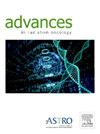超弧自动立体定向放射外科计划通过遵守HyTEC毒性阈值,实现准确的先验分选方案
IF 2.7
Q3 ONCOLOGY
引用次数: 0
摘要
目的放射手术计划安全性通常通过接受特定剂量(即12 Gy/1分数[fx])的体积来估计,并在计划产生后进行评估。然而,自动化的治疗计划可以产生高度一致和可预测的计划。因此,我们假设HyperArc (HA)自动立体定向放射外科(SRS)计划可以在计划生成之前进行临床决策,例如选择合适的SRS分路方案。方法和材料我们查询了我院所有先前治疗过的单等中心HA计划,共有3361个边缘靶点未在50%等剂量水平桥接(1495个计划),使其成为作者所知的最大的单机构SRS剂量学研究。计算所有HA靶点的8个等剂量体积(idv; 50.00%-97.60%),每个等剂量体积对应于高剂量/分数、临床低分数治疗效应(HyTEC)脑毒性剂量水平和常用处方剂量(例如,50.00% = 12 Gy/24 Gy)的比例。从361个靶标(10.7%)的训练数据集生成IDV与靶体积的幂律关系(IDV=aVtargetb),并在其余3000个靶标(89.3%)上进行验证,从而可以根据靶体积预测1至3级脑毒性。结果应用于验证队列时,模型的R²值较高(≥0.982),允许将目标分类为高于或低于HyTEC阈值(IDV = 5 cm3, 10 cm3和20 cm3),准确度(≥97.6%)和精密度(≥99.3%)较高。例如,50.0%的IDV模型预测,当处方剂量为24 Gy/1时,靶体积/直径分别为1.00 cm /1.24 cm、2.34 cm /1.65 cm和5.51 cm /2.19 cm时,脑毒性率分别为3.6%、4.8%和8.6%。根据HyTEC毒性估计,所得到的模型能够准确和精确地预测靶体积/直径,分别得出3.6%、4.8%和8.6%的脑1至3级毒性率。利用相对idv而不是处方剂量,可以将所有3361个靶点用于9种常见SRS处方的建模(1 fx: 24 Gy、20 Gy、18 Gy、16 Gy和15 Gy; 3 fx: 27 Gy和24 Gy; 5 fx: 30 Gy和25 Gy),使临床医生能够通过开源计算器先验地估计脑毒性。本文章由计算机程序翻译,如有差异,请以英文原文为准。
HyperArc Automated Stereotactic Radiosurgery Planning Enables Accurate a Priori Fractionation Scheme Selection via Adherence to HyTEC Toxicity Thresholds
Purpose
Radiosurgery plan safety is commonly estimated by volumes receiving specific doses (ie, 12 Gy/1 fraction [fx]), which are evaluated postplan generation. However, automated treatment planning can produce highly consistent and thus predictable plans. Thus, we hypothesized that HyperArc (HA) automated stereotactic radiosurgery (SRS) planning enables clinical decision-making prior to plan generation, such as selecting the appropriate SRS fractionation scheme.
Methods and Materials
All previously treated single-isocenter HA plans at our institution were queried, totaling 3361 marginless targets without bridging at the 50% isodose level (1495 plans), making this the largest single-institutional SRS dosimetry study to the authors’ knowledge. Eight isodose volumes (IDVs; 50.00%-97.60%) were calculated for all HA targets, each corresponding to the ratio of a High Dose per Fraction, Hypofractionated Treatment Effects in the Clinic (HyTEC) brain toxicity dose level and a common prescription dose (eg, 50.00% = 12 Gy/24 Gy). Power law relationships of IDV and target volume () were generated from a training data set of 361 targets (10.7%) and validated on the remaining 3000 targets (89.3%), allowing grade 1 to 3 brain toxicity rates to be predicted from target volume.
Results
Models resulted in high R² values when applied to the validation cohort (≥0.982), allowing targets to be classified as either above or below the HyTEC thresholds (IDV = 5 cm3, 10 cm3, and 20 cm3) with high accuracy (≥97.6%) and precision (≥99.3%). As an example, the 50.0% IDV model predicted that target volumes/diameters of 1.00 cm3/1.24 cm, 2.34 cm3/1.65 cm, and 5.51 cm3/2.19 cm correlate with 3.6%, 4.8%, and 8.6% grade 1 to 3 brain toxicity rates, respectively, when prescribing 24 Gy/1 fx.
Conclusion
The resulting models enabled accurate and precise prediction of target volumes/diameters, resulting in 3.6%, 4.8%, and 8.6% brain grade 1 to 3 toxicity rates, according to HyTEC toxicity estimates. Leveraging relative IDVs rather than prescription doses enabled all 3361 targets to be used for modeling 9 common SRS prescriptions (1 fx: 24 Gy, 20 Gy, 18 Gy, 16 Gy, and 15 Gy; 3 fx: 27 Gy and 24 Gy; 5 fx: 30 Gy and 25 Gy), enabling clinicians to estimate brain toxicity a priori via an open-source calculator.
求助全文
通过发布文献求助,成功后即可免费获取论文全文。
去求助
来源期刊

Advances in Radiation Oncology
Medicine-Radiology, Nuclear Medicine and Imaging
CiteScore
4.60
自引率
4.30%
发文量
208
审稿时长
98 days
期刊介绍:
The purpose of Advances is to provide information for clinicians who use radiation therapy by publishing: Clinical trial reports and reanalyses. Basic science original reports. Manuscripts examining health services research, comparative and cost effectiveness research, and systematic reviews. Case reports documenting unusual problems and solutions. High quality multi and single institutional series, as well as other novel retrospective hypothesis generating series. Timely critical reviews on important topics in radiation oncology, such as side effects. Articles reporting the natural history of disease and patterns of failure, particularly as they relate to treatment volume delineation. Articles on safety and quality in radiation therapy. Essays on clinical experience. Articles on practice transformation in radiation oncology, in particular: Aspects of health policy that may impact the future practice of radiation oncology. How information technology, such as data analytics and systems innovations, will change radiation oncology practice. Articles on imaging as they relate to radiation therapy treatment.
 求助内容:
求助内容: 应助结果提醒方式:
应助结果提醒方式:


